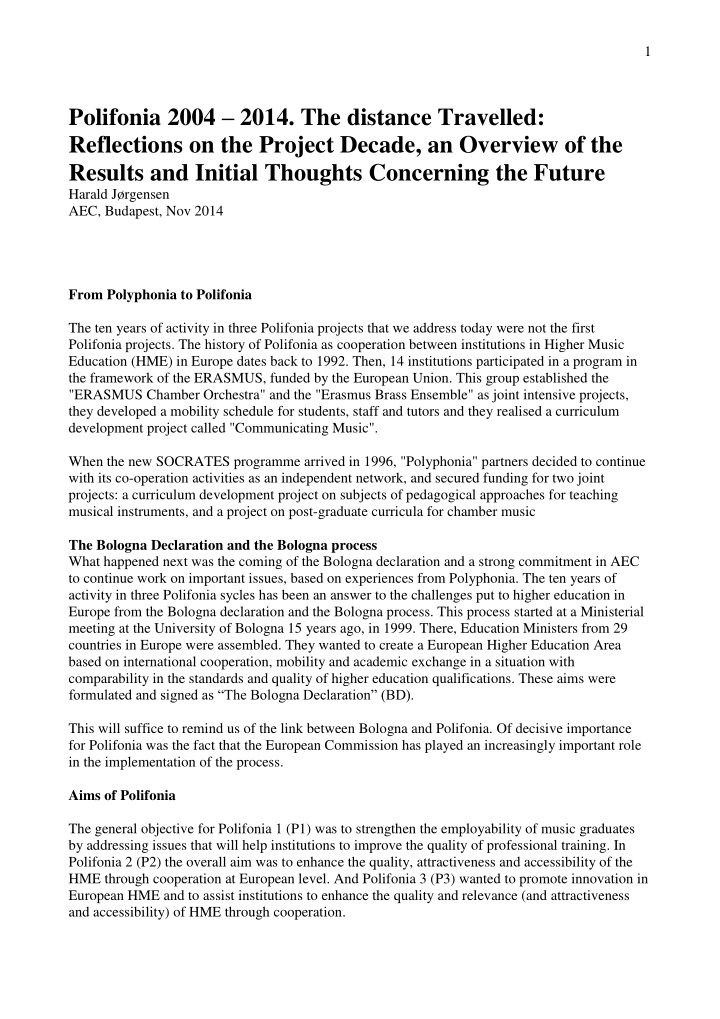



1 Polifonia 2004 – 2014. The distance Travelled: Reflections on the Project Decade, an Overview of the Results and Initial Thoughts Concerning the Future Harald Jørgensen AEC, Budapest, Nov 2014 From Polyphonia to Polifonia The ten years of activity in three Polifonia projects that we address today were not the first Polifonia projects. The history of Polifonia as cooperation between institutions in Higher Music Education (HME) in Europe dates back to 1992. Then, 14 institutions participated in a program in the framework of the ERASMUS, funded by the European Union. This group established the "ERASMUS Chamber Orchestra" and the "Erasmus Brass Ensemble" as joint intensive projects, they developed a mobility schedule for students, staff and tutors and they realised a curriculum development project called "Communicating Music". When the new SOCRATES programme arrived in 1996, "Polyphonia" partners decided to continue with its co-operation activities as an independent network, and secured funding for two joint projects: a curriculum development project on subjects of pedagogical approaches for teaching musical instruments, and a project on post-graduate curricula for chamber music The Bologna Declaration and the Bologna process What happened next was the coming of the Bologna declaration and a strong commitment in AEC to continue work on important issues, based on experiences from Polyphonia. The ten years of activity in three Polifonia sycles has been an answer to the challenges put to higher education in Europe from the Bologna declaration and the Bologna process. This process started at a Ministerial meeting at the University of Bologna 15 years ago, in 1999. There, Education Ministers from 29 countries in Europe were assembled. They wanted to create a European Higher Education Area based on international cooperation, mobility and academic exchange in a situation with comparability in the standards and quality of higher education qualifications. These aims were formulated and signed as “The Bologna Declaration” (BD). This will suffice to remind us of the link between Bologna and Polifonia. Of decisive importance for Polifonia was the fact that the European Commission has played an increasingly important role in the implementation of the process. Aims of Polifonia The general objective for Polifonia 1 (P1) was to strengthen the employability of music graduates by addressing issues that will help institutions to improve the quality of professional training. In Polifonia 2 (P2) the overall aim was to enhance the quality, attractiveness and accessibility of the HME through cooperation at European level. And Polifonia 3 (P3) wanted to promote innovation in European HME and to assist institutions to enhance the quality and relevance (and attractiveness and accessibility) of HME through cooperation.
2 In short: The overall aim was to enhance quality in our institutions through cooperation, and to facilitate cooperation and mobility of students through comparable educational structures and curricula. The common framework for the transformation of the institutions was a suggested three- cycle structure. Activities in working groups Polifonia has organized its work in working groups, five in each cycle, and with an average of 7-8 members in each group. HME institutions from a total of 25 countries in Europe have been involved in the working groups. In P1 and P2, more than 60 institutions were partner institutions, while P3 had more than 40 partners. Representatives from external institutions and organisations were also involved, and contributed significantly to specific issues. Group meetings have been distributed as much as possible to partner institutions that were not represented in the working groups. Some groups or members of groups went on site visits, to study specific practices in an institution. In addition there were seminars and workshops. Throughout these ten years, AEC has proved it’s excellence in the organisation of a rather complicated adventure. Issues addressed by Polifonia The basic issue of cyc les was addressed in P1, where the “3 rd cycle group” described the current status and latest trends in relation to 3 rd cycle studies in European HME, identifying 40 institutions that offered 3 rd cycle studies in 2006. There may have been more, but the overall picture told us that the majority of institutions had a two-cycle structure. Based on the cycle structure, the BD and subsequent Ministerial meetings gave several recommendations to institutions. Two of them were rather basic if we want comparable studies across the continent. The first one addresses what we want the students to do and to know when they leave us, their competences, defined not in broad statements like “high quality”, but as specific statements of knowledge and skill. This is the issue of ‘Learning outcomes’, and it has been addressed in several groups in both P1 and P2. Learning outcomes for each of the three cycles have been developed, influenced by the so-called Dublin descriptors provided in 2002. To coordinate the outcomes in a progression through the three cycles has been a challenging task, and learning outcomes have been an important framework for issues related to curriculum development and assessment, addressed in both P1 and P2. Another basic recommendation from the BD process that intended to enhance comparability of studies was the introduction of the European Credit Transfer and Accumulation System (ECTS), giving a quantitative description of workload of programs and study modules. P1 addressed credit points and published a handbook as a helping hand to institutions. In a situation where many institutions were faced with new cycles, ECTS and learning outcomes, curriculum reform was necessary, and curriculum design and development was addressed in both P1 and P2. A special c urriculum issue that entered all three P cycles was “research”. In P1, research was addressed as a central activity in the 3 rd cycle, while P2 addressed the range of research activities taking place in institutions. Then, in P3, one group has addressed “artistic research”, and established a European meeting- place (a “platform”) for artistic research in music. This group has also looked at how programmes in the 2 nd cycle should combine professional preparation with preparation for relevant Doctoral study in the 3 rd cycle.
Recommend
More recommend